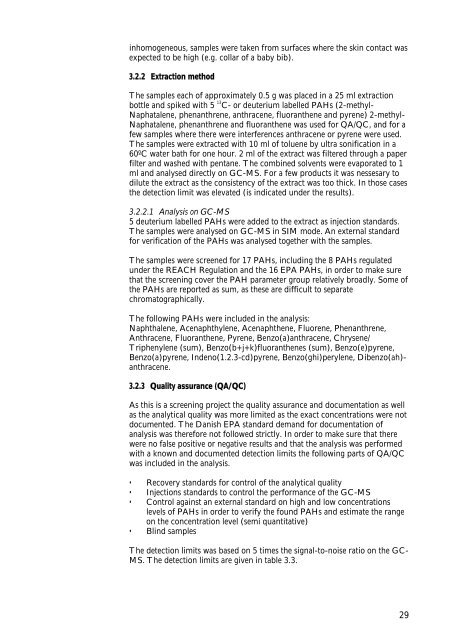PAHs in toys and childcare products - Miljøstyrelsen
PAHs in toys and childcare products - Miljøstyrelsen
PAHs in toys and childcare products - Miljøstyrelsen
You also want an ePaper? Increase the reach of your titles
YUMPU automatically turns print PDFs into web optimized ePapers that Google loves.
<strong>in</strong>homogeneous, samples were taken from surfaces where the sk<strong>in</strong> contact was<br />
expected to be high (e.g. collar of a baby bib).<br />
3.2.2 Extraction method<br />
The samples each of approximately 0.5 g was placed <strong>in</strong> a 25 ml extraction<br />
bottle <strong>and</strong> spiked with 5 13<br />
C- or deuterium labelled <strong>PAHs</strong> (2-methyl-<br />
Naphatalene, phenanthrene, anthracene, fluoranthene <strong>and</strong> pyrene) 2-methyl-<br />
Naphatalene, phenanthrene <strong>and</strong> fluoranthene was used for QA/QC, <strong>and</strong> for a<br />
few samples where there were <strong>in</strong>terferences anthracene or pyrene were used.<br />
The samples were extracted with 10 ml of toluene by ultra sonification <strong>in</strong> a<br />
60ºC water bath for one hour. 2 ml of the extract was filtered through a paper<br />
filter <strong>and</strong> washed with pentane. The comb<strong>in</strong>ed solvents were evaporated to 1<br />
ml <strong>and</strong> analysed directly on GC-MS. For a few <strong>products</strong> it was nessesary to<br />
dilute the extract as the consistency of the extract was too thick. In those cases<br />
the detection limit was elevated (is <strong>in</strong>dicated under the results).<br />
3.2.2.1 Analysis on GC-MS<br />
5 deuterium labelled <strong>PAHs</strong> were added to the extract as <strong>in</strong>jection st<strong>and</strong>ards.<br />
The samples were analysed on GC-MS <strong>in</strong> SIM mode. An external st<strong>and</strong>ard<br />
for verification of the <strong>PAHs</strong> was analysed together with the samples.<br />
The samples were screened for 17 <strong>PAHs</strong>, <strong>in</strong>clud<strong>in</strong>g the 8 <strong>PAHs</strong> regulated<br />
under the REACH Regulation <strong>and</strong> the 16 EPA <strong>PAHs</strong>, <strong>in</strong> order to make sure<br />
that the screen<strong>in</strong>g cover the PAH parameter group relatively broadly. Some of<br />
the <strong>PAHs</strong> are reported as sum, as these are difficult to separate<br />
chromatographically.<br />
The follow<strong>in</strong>g <strong>PAHs</strong> were <strong>in</strong>cluded <strong>in</strong> the analysis:<br />
Naphthalene, Acenaphthylene, Acenaphthene, Fluorene, Phenanthrene,<br />
Anthracene, Fluoranthene, Pyrene, Benzo(a)anthracene, Chrysene/<br />
Triphenylene (sum), Benzo(b+j+k)fluoranthenes (sum), Benzo(e)pyrene,<br />
Benzo(a)pyrene, Indeno(1.2.3-cd)pyrene, Benzo(ghi)perylene, Dibenzo(ah)anthracene.<br />
3.2.3 Quality assurance (QA/QC)<br />
As this is a screen<strong>in</strong>g project the quality assurance <strong>and</strong> documentation as well<br />
as the analytical quality was more limited as the exact concentrations were not<br />
documented. The Danish EPA st<strong>and</strong>ard dem<strong>and</strong> for documentation of<br />
analysis was therefore not followed strictly. In order to make sure that there<br />
were no false positive or negative results <strong>and</strong> that the analysis was performed<br />
with a known <strong>and</strong> documented detection limits the follow<strong>in</strong>g parts of QA/QC<br />
was <strong>in</strong>cluded <strong>in</strong> the analysis.<br />
• Recovery st<strong>and</strong>ards for control of the analytical quality<br />
• Injections st<strong>and</strong>ards to control the performance of the GC-MS<br />
• Control aga<strong>in</strong>st an external st<strong>and</strong>ard on high <strong>and</strong> low concentrations<br />
levels of <strong>PAHs</strong> <strong>in</strong> order to verify the found <strong>PAHs</strong> <strong>and</strong> estimate the range<br />
on the concentration level (semi quantitative)<br />
• Bl<strong>in</strong>d samples<br />
The detection limits was based on 5 times the signal-to-noise ratio on the GC-<br />
MS. The detection limits are given <strong>in</strong> table 3.3.<br />
29

















